Bongo Habitat at Ragati Conservancy
Mara River Basin
|
NEW ESRI StoryMaps: What's On Our Shelves & NWNL Song Library & No Water No Life ESRI |
Mara River Basin
Malte Sommerlatte
Ragati Conservancy, Director
Brendan Gill
Ragati Conservancy Investor/Construction Engineer
Alison M. Jones
NWNL Executive Director
Mike Prettejohn
Director, Bongo Surveillance Project
Forest Fauna & Fires
Forestry Stewardship
Ragati Vision
Ragati Conservation
Fauna & Flora Conservation
Fishing In Ragati Conservancy
Ragati’s Successes – Thus Far
Bongo Reintroduction
Ragati’s Future Projects
Community Development Goals
All images © Alison M. Jones. All rights reserved.
As a German forester raised in South Africa, Malta Sommerlatte has worked in Botswana, South Sudan, Uganda, Mozambique, and South Africa. He also helped reintroduce lynx to Austria’s Alps. He has taught forestry in Kenya and been a consultant for Richard Leakey and for Brian Heath, CEO of the Mara Conservancy. Malte has written management plans for Kenya’s National Parks & Reserves and other private entities.
Now, Malta is providing a critical need in the Bongo Surveillance Project’s reintroduction of endangered bongo by opening his Ragati Conservancy on Mt Kenya to bongo returned from zoos worldwide. Once their original habitat in the Mau Forest, source of the Mara River, is secured from poachers, the Ragati bongo will be returned to the Mau.

NWNL Arriving here in Mt Kenya’s 8,000-acre Ragati Forest, I wish I were better at tree identification. Please teach me about Ragati’s indigenous vegetation.
MALTE SOMMERLATTE As you came the main dirt road, you passed plantations with 60-to-70-year-old Meru oak trees (Vitex kenyensis), which are indigenous and very good for furniture. Then we met under a beautiful strangler fig treee.

NWNL Walking along the Ragati River, there’s great diversity of vegetation. For instance, including stinging nettle eaten by bongo and podocarpus trees.
MALTE SOMMERLATTE Also widespread in Mau Forest high elevations, the podocarpus (Podocarpus latifolia) here grows to about 2,300-2,800 meters. Informally called “Yellowwood,” it’s the most dominant “climax tree” in this area [i.e., a stable species that germinates with limited resources, such as low water availability].
NWNL What is forest-edge fern?
MALTE SOMMERLATTE Flying over some of these forests, you can see intact forest edges with 20-30 meter-wide buffer zones where ferns and bushes separate grassland from forest. But with fire encroachment, many forests have no edges. In those cases, grassland goes right up to the forest. That means that every fire eats more and more into the forest.
NWNL Fire issues are now a huge problem in the United States. Is that so in Kenya?
MALTE SOMMERLATTE We do have fire issues. Our honey-gatherers smoke out wild bees, but don’t put out the fire, so it catches and expands. In very dry seasons, clouds of this smoke are scattered through the forest from the Aberdare National Park/Mt. Kenya main road. We also have forest fires started by illegal charcoal burners and by pastoralists (livestock owners) wanting patches of new grass. If they do this year after year, those grasses eventually die out, leaving only fire-resistant grasses or shrubs which regenerate quicker than other grasses.

As populations and livestock numbers increase, there’s a huge demand for grasslands. One way to create grassland is to destroy the forest. Pastoralists are only interested in grasslands and open woodlands where they can drive their cattle. The inside of a forest has very little grass and cannot properly maintain their hundreds or thousands of cattle. So, they get rid of forests by burning them down. They are pyromaniacs.
NWNL How does Kenya manage such forest fires? Do you let them burn?
MALTE SOMMERLATTE The policy is to put it out. But who will do that? Is there enough manpower? Are there enough vehicles? Is there enough money to put a fire out?
The people on the front line are the Kenya Forest Service (hereon, KFS), the individual forester and his gang of people. One idea of “whole community involvement” – to which we subscribe – is for the community to help put out a fire, because they benefit from the forest, especially its water.
The community needs and gets a little money from tourism and a bit more here or there; but mainly they need water. I think they’ve realized that if forests burn down, there’ll be less and less water over time – not immediately, of course, but over time.
So, public-minded community members and Europeans join in to fight these forest fires. The fires are not as enormous as those in N. America or Australia. In Europe, forest fires are small because there are no pines to burst into flames, except in Spain or southern Italy. Kenya’s trees don’t have that resin.
NWNL Will you describe forest values in Kenya in general and here on Mt Kenya?
MALTE SOMMERLATTE Forests have many values, documented internationally and by universities. My sense of their values is their diversity – especially plant species. People always talk about animal species, which are equally important. But we can’t forget plants. After all, forest animals are associated with plants – so forest values are in both.
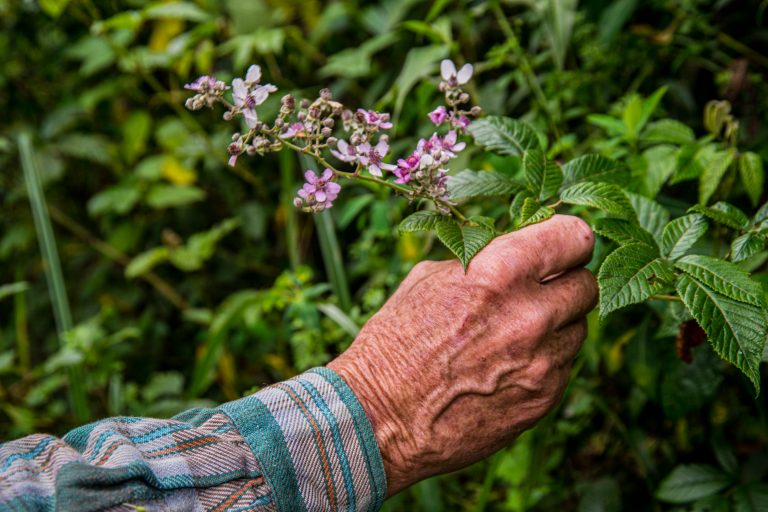
NWNL And what is the value of such diversity?
MALTE SOMMERLATTE Ah, good question. It’s important, especially in the 21st century, because the world is becoming more boring, over-populated and less diverse. Diversity is an absolute essence of life, in both the natural world and human world. Photographs of how people dressed 100 years ago are magnificent: the Arabs, Ottomans and so forth. That is lacking and reflects our society becoming poorer. Our society needs places where they can still see diversity.
NWNL How do you, as a forester, assess a landscape?
MALTE SOMMERLATTE German foresters in uniform led training excursions into the forest. They’d stand up and ask, “Gentlemen, what do you see?”
“I see beeches there and a bit of regeneration here. There’s a stream over there. I see footprints of roe deer and red deer and their browsing damage.” It was like going into the Tate Gallery to study a photograph. The forester was perfectly right! We should look at the broader picture, and only then turn into the specifics.
That was the essence of my four years in forestry. So, my point of view is to study the landscape, and then individual actors in the landscape – from elephants to all else. I might say, “Ah, this type of vegetation is going to be in the valley bottom; this is going to be halfway up. Klipspringers are up on the rock kopjes and reebok next to the rivers in higher grass. Buffalo come down to the river in the evenings for the water….” I start any excursion into the wild as a painting.
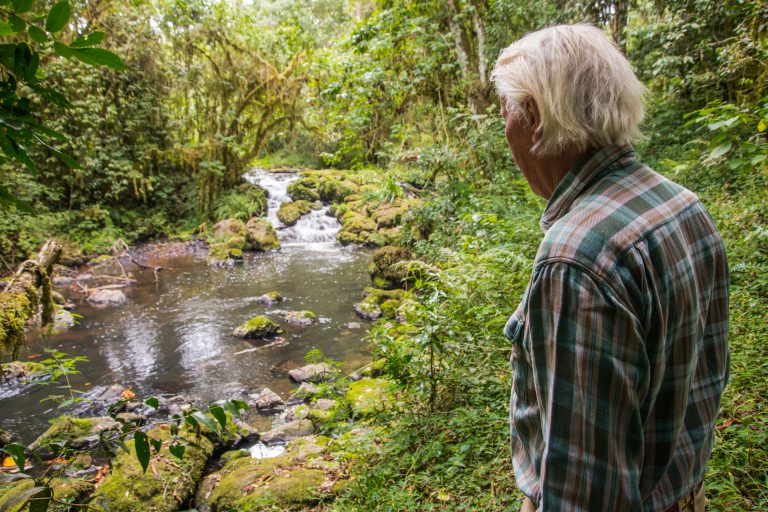
NWNL What are the greatest threats today to Kenya’s forest ecosystems?
MALTE SOMMERLATTE The outrageous political threat was willful decimation of the forest by politicians and their henchmen. But that changed with the new 2015 Forest Conservation and Management Bill. Before it was chaotic, and forests were something to be excised – to be given to your mistress, your buddies, your grandmother and so on.
Now that is more difficult. Any excision must go through Parliament. National parks are sacrosanct, due to international observance and the high-profile of wildlife. Kenya has the prima donnas of wildlife conservation. They are very good. But forestry didn’t have high-profile heroes, like Cynthia Moss or Richard Leakey. So, it was much easier to excise forests, especially given their excellent soils.
NWNL What are the impacts of growing populations moving into the forests?
MALTE SOMMERLATTE Fifteen years ago, I did a study for Food and Agricultural Organization/FAO Rome on how water affects the livelihood of shamba owners [farmers of 2 to 3 acres]. I interviewed people around Mt. Kenya on whether giving a farmer more pipe water would improve his livelihood. I showed that if they had water, their production would increase by 25% and their income by 33%.
NWNL What are the three keys to successful stewardship of Kenya’s forests?
MALTE SOMMERLATTE First, the Forest Act says you can’t excise forests as you used to. It also incorporated a community element. Stewardship is hit-and-miss. It can be successful or catastrophic – depending on the community. Usually, it’s catastrophic because people want benefits, but not the obligations.
NMIKE PRETTEJOHN Africans have a short life. So, because life is so difficult, they make what they can as quickly as they can. [Read Mike’s NWNL interview “Bongos Save Forests” for more on his bongo surveillance project.]
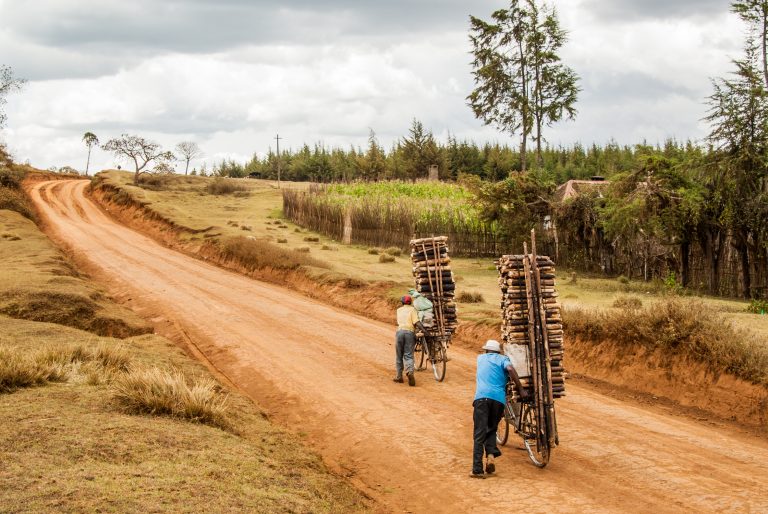
MALTE SOMMERLATTE Yes. Europeans have hundreds of years of sustainability. The first forestry book in Germany was published in 1780 – not 30 years ago. With training, stewardship in Africa will change to successfully becoming more sustainable.
NWNL What difference has the Forest Act of 2015 made?
MALTE SOMMERLATTE It seems forest rangers are better funded and have uniforms. They’re now armed when they go out on patrol, so their morale has increased. Theoretically and hopefully, they recognize their contribution to conservation and management. This installs a certain esprit de corps.
Morale goes down when politicians act with absolute impunity as they excise several hundred hectares of the forest and turn it into shambas. As an administrator or as a forest guard, that would affect me enormously. I’d ask, “Why the hell should I risk my life at 5,000 bob a month (US $50), if these oafs can do that?
NWNL Does this 2015 Act ban excisions outright?
MALTE SOMMERLATTE Requests must go through Parliament, which makes step-by-step bureaucracy much more difficult. Before, excisions occurred at the drop of a hat and were a local decision and never discussed in Parliament or at cabinet level.
NWNL Given your broad background, what led you to set up Ragati Conservancy and your multi-pronged project to establish a protected forest for the remaining, endangered mountain bongo.
MALTE SOMMERLATTE I am old-fashioned forester from Germany, where forestry, hunting and wildlife management go hand in hand. In West Africa, the French, like Germans and Austrians, combined forestry and wildlife. Yet, in East Africa’s Kenya, the English had a different system. They were much more interested in hunting, so they separated their National Parks and Game Reserves wildlife management from their Forest Reserves.
NWNL Since my NWNL focus is on the Mara River Basin, may I ask how you assess the state of the Mau Forest, which contains the headwaters of the Mara River?
MALTE SOMMERLATTE Fifteen years ago, I did a few consultancies on game counts and tourism on a ranch bordering Maasai Mara National Reserve. While I’ve also flown over the Mau Forest, my specific knowledge of its recent destruction is from the media. I feel Ragati Conservancy here on Mt Kenya could be replicated in the Aberdare National Park (hereafter Aberdare NP) and elsewhere – but not necessarily in the Mau Forest.
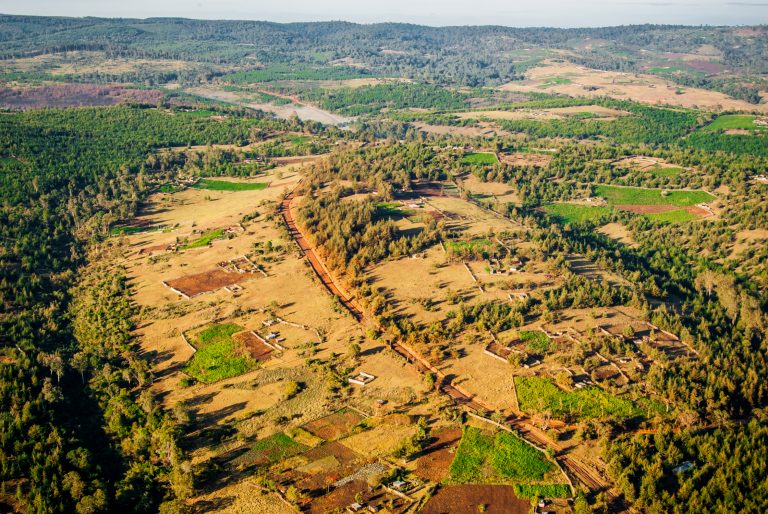
NWNL How did Ragati Conservancy evolve?
MALTE SOMMERLATTE As a forester, I have good contacts with KFS and suggested they open their forest reserves. I wanted to replicate Zimbabwe’s Campfire Project which had successful community involvement projects. Their community-based conservation includes hunting safaris, tourism walking safaris and fishing safaris along Lake Kariba and Mana Pools. It took them 1-2 years to start up those models.
One day a group of Kenyan Kikuyus asked, “We hear you’re a forester interested in wildlife. Why don’t you look at Ragati Forest?” I saw the potential and undertook this project.
NWNL Why did they want you to come in to do this?
MALTE SOMMERLATTE Well, the Kenya Forest Service [hereon, KFS] was explicit in its 2016 Forest Conservation and Management Act [following the 2015 Act] that such endeavors must include community development – a growing mantra throughout Africa. In a way, I am partially responsible, having started the first course on community development at Tanzania’s Mweka College of African Wildlife Management and the African Wildlife Foundation/AWF course for African game wardens in Nairobi.
The Kikuyu knew the Forest Conservation and Management Act of 2016 had a big section on community involvement, which meant money. So, they wanted someone to develop this area with them and KFS. I didn’t have funding, but I jumped on it and hung on. I’ve paid 5 or 6 people for about 2 years. Finally, we opened this forest track using quite a lot of labor. Importantly, we hardly cut down any big trees, which is why it’s rather bumpy and winding.
I set up a company in 2014 with two investors: Brendan Hill and Nick Rowe. Brendan is a Kenyan citizen from the foothills of Mt Kenya. Nick’s father was a District Forester.
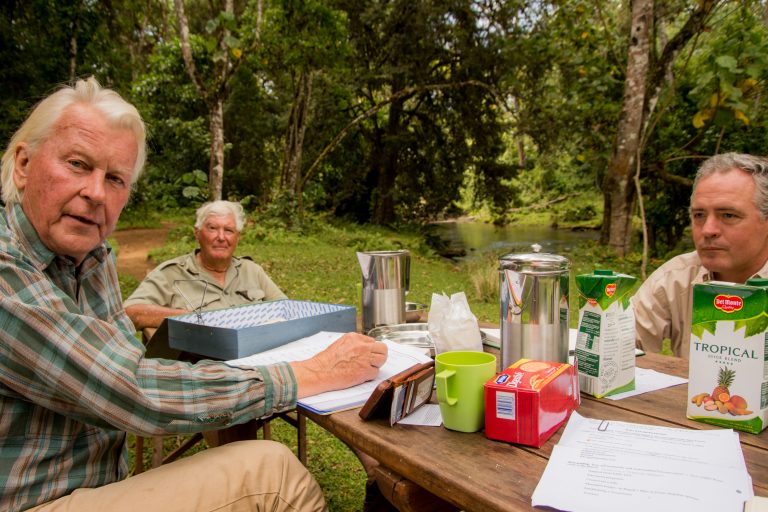
MALTE SOMMERLATTE Initially, we had one 2-acre site, but I was focused on a broader picture. I’d managed private forest estates in South Africa and worked for Botswana’s Wildlife Department for years at Chobe/Kasani. So, I lobbied for a bigger area. We got 4 sites with a 50-year renewable lease and “use zone” of 5,000 hectares. That is quite a bit in mountain areas. I’ve walked only about half the area here!
NWNL How did you choose Ragati Forest?
MALTE SOMMERLATTE It was good luck and a forester’s eye for the potential. They gave me 2 days to choose our sites. I raced up to the log cabin site, via an old logging road. By some fluke, I chose the best site for a trout farm – with no knowledge of trout farming. I chose a site for a mountaineers’ basecamp while climbing Mt. Kenya which I thought would be the most interesting aspect of Ragati. But fishing became more important and much more successful.
Then we sent management and community development plans to KFS. Brendan, as a construction engineer, designed and built the log cabin. Then NEMA [National Environmental Management Authority] approved us as a Conservancy. As Brendan now says, Ragati Conservancy could be a pilot project. Other nearby foresters ask if we’ll expand into their area.
NWNL Malte, what wildlife typically lives in Kenya’s forests?
MALTE SOMMERLATTE Kenya’s forests are managed by KFS, which in colonial days had very little interest in their wildlife. However, these mountain forests hold a lot of endemic and interesting species. Bongo, golden cat, crowned eagle, tree hyrax – you name it – are specific to the forest.
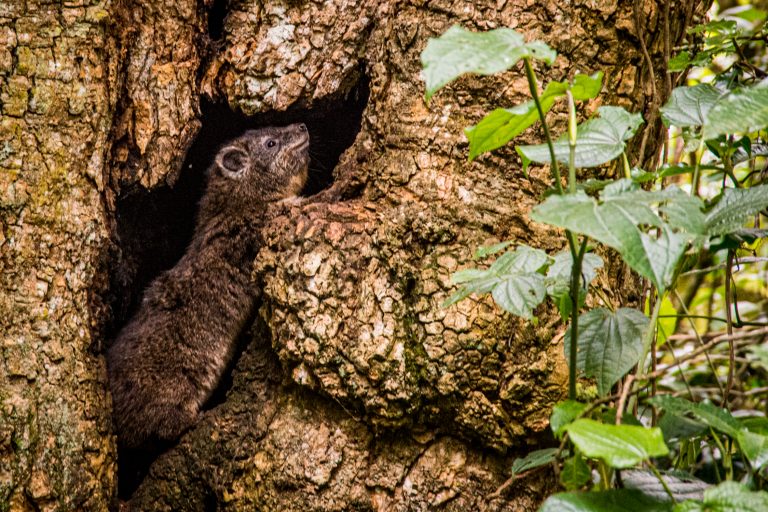
But they are not iconic, well-known savanna species like buffalo and elephant. The Forest Service is still hamstrung by the wildlife people. Over the last 50-70 years, Kenya’s wildlife species were financially protected, unlike plants and trees.
Here on Mt. Kenya, KWS is still basically in charge of the wildlife. That is also perpetuated in Kenya’s Forestry College in Londiani bordering the Mau Forest.
Unfortunately, their foresters only teach management of plantations of pines, cypress, and eucalyptus. Basically, students learn old-fashioned plantation management with very little emphasis on wildlife or natural forests. That must change, and they’ve realized it. The Forest Act mentions wildlife and community, so they’ve realized there’s more to forestry than just plantations.
BRENDAN HILL Mt Kenya is unique because Richard Leakey, as Chair of KWS, brought its boundary down around this forest. Ragati is one of the only areas on the mountain where the KWS and KFS manage the same spot.
MALTE SOMMERLATTE Leakey and I worked together to allow this co-management, because these indigenous forests are extremely important to wildlife. But co-management didn’t really work.
BRENDAN HILL I think it’s because they didn’t communicate. But it’s much better now, given what we’re doing now with bongo.
MALTE SOMMERLATTE Much depends on personal contacts. I spent a hell of a lot of time chatting with people.
NWNL “Chatting” is such a critical conservation approach in Kenya. That word should be used more often in U.S. conservation.
NWNL How did you develop Ragati Conservancy?
MALTE SOMMERLATTE After access roads, we needed sites for the log cabins, tented camps, basecamp, and a trout-farm. We divided Ragati River into 8 or 10 one-kilometer “beats” as references for fly fisherman, our catch-and-release system and restocking by ghillies [fishing guides], whom we and our visitors have trained.
BRENDAN HILL We’ve been told by fly fishers, that our ghillies are the best in this country.
MALTE SOMMERLATTE We restock our river quarterly with 100-150 fish. Last year we restocked 650 rainbow trout from Kiganjo Trout Farm.
BRENDAN HILL In 2015, we caught probably about 50 brown and rainbow trout from the other side of the mountain because we couldn’t get them from anywhere else.
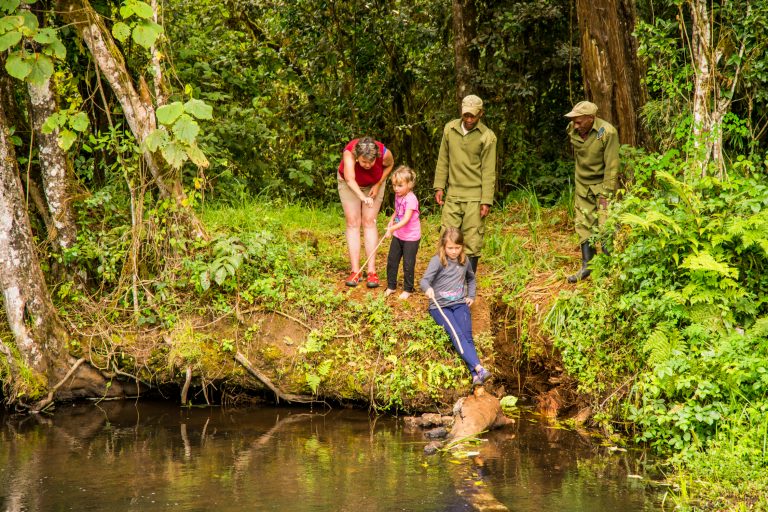
MALTE SOMMERLATTE Having realized that fishing is an enormous attraction – more than mountaineering – we went for the bait. In the first year we had 400 visitors; in the second year, about 500; and last year about 650. All just by word of mouth…,
BRENDAN HILL … and a Facebook page. We superseded all our expectations. The beauty of this forest really pulls people here. Reason #1 is there is incredibly special about this river and this forest. Plus, the ghillies and others we’ve trained are lovely guys. We have such good reports about them. They’ve really done us proud.
Also, Ragati is a green environment, versus other very dry areas around the mountain and elsewhere in Kenya, so Ragati offers a get-away from arid regions. Ragati’s fantastic fishing is some of the best in East Africa.
MALTE SOMMERLATTE There’s a fly-fishing club on the southern end of the Aberdare NP and 70% of their fly fishers come up to Ragati. That’s phenomenal, considering they have their own river and lodge down there.
NWNL Are there other similar setups in the Aberdare NP?
MIKE PRETTEJOHN The Aberdare NP has some fishing bandas [cabins] near little trout ponds and stocked rivers, with tented camps or little lodges. On the northern slopes of Mt Kenya, is Rutundu, a lovely log cabin built in classic Norwegian style on Lake Alice.
NWNL What is special about Ragati?
MALTE SOMMERLATTE I think Ragati has been so successful because it is only 2.5 hours from Nairobi. People can leave easily leave early Friday and return on Sunday afternoon. It’s very accessible. Yet the cozy Rutundu cabin in the Aberdare NP is a good 6 or 7 hours from Nairobi.
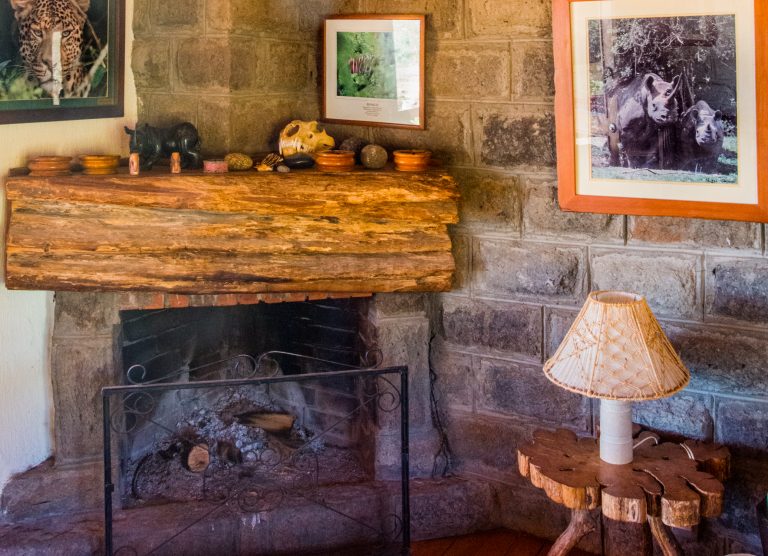
Ragati has great potential. When other foresters ask us to look at their rivers, I say, “Well, we can’t compete with Scotland, Austria or North America.” One Scotsman responded, “But Kenya has elephants. No trout-fishing venues have elephants.” Okay, you don’t see elephants within Ragati, thankfully; but it’s quite special that their habitats are nearby.
By the way, this not a jungle. I’ve been to West Africa’s Congolese jungle quite a few times. Unlike the Congo, Ragati offers relatively easy walking because it’s a mature forest. As a podocarpus forest, undergrowth is very open, so visitors can easily follow a game trail or old elephant migration tracks — or just trundle through themselves.
BRENDAN HILL And as you walk, you can see quite long distances as well.
MALTE SOMMERLATTE Visitor numbers have been successful. We have high running costs, but what profit we do have is plowed back and used to pay down our few small debts (totaling about $20,000. US). Fortunately, we don’t have a big staff and none of our 3 directors take a salary.
NWNL Do you think there is increased interest in fishing?
BRENDAN HILL Very much so. When we started four years ago, people were stocking dams on Mt. Kenya, but not on smaller streams and rivers. It’s slowly changing. Now people are teaching communities how to fish. Mt Kenya is one of Kenya’s great water towers – so fishing and conservation here go hand in hand. We keep these rivers clean. We look after and monitor them and report on our success.
More people are now stocking their dams and rivers here on Mt. Kenya and the Aberdare NP. Interestingly, the original litmus test here for healthy forests, certainly for the English colonies, was whether you could fish for trout. That was then a gentleman’s pastime.
Now from South Africa to Kenya and Sudan, we now have trout in our rivers. Our first stocked trout came from Mombasa [a Kenyan coastal city]. But back then, they came by ship from America to South Africa’s Cape. They were then loaded onto donkeys and taken with an American watchman up into Hottentot Holland’s mountains, into the Drakensberg and so on. In Kenya’s colonial times, there was a lot of fishing. That petered out a bit when many Europeans left Kenya at Independence, but now it seems to be increasing again.
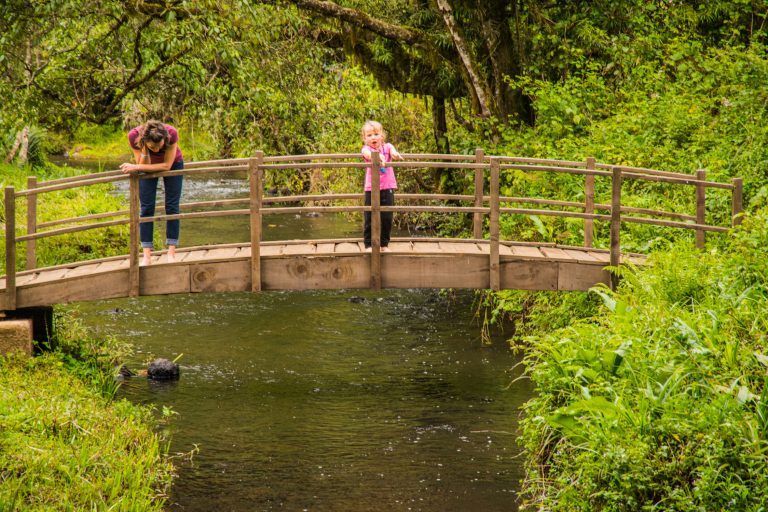
NWNL Are your visitors mostly Europeans?
MALTE SOMMERLATTE Yes, but please understand, one of our main objectives is to get Africans onboard. I would very much like to find someone to teach a 3 or 4-day course in fly fishing. To get Africans involved in fishing, we’d offer courses at a very reasonable price – or just for fun, just for publicity within their communities. Then it would more than just a colonial European sport.
NWNL Are your ghillies African?
MALTE SOMMERLATTE Yes, all of them. We work well with them and we have good relations with Kenyan government agents. Simon Gitau, the KWS Mountain Region Assistant Director and Ecosystem Conservator, is very open to assisting. I also deal with Orare, a forester in Karua at KFS in charge of tourism. He’s young, so doesn’t have much power within KFS, but he’s helpful. Mr. Waru is our Ragati Forester; and Mr. Kasinji is important to us as the Nyeri County Ecosystem Conservator in charge of all KFS guys around the mountain. He’s a good guy.
There are also, of course, our adjacent foresters. We have six permanent staff, as well as a lot of casuals who were helpful, especially when I cleared the tract here. When a tree falls, it must be cleared.
NWNL Malte and Mike, I’m excited about your efforts to re-introduce mountain bongo to Kenya. You have camera traps set up at Rutundu to record bongos in the Aberdare NP.Your next plan is to bring bongo, returned from zoos worldwide, to Ragati Forest to adjust to Ragati Forest. I am anxious to hear more, as I believe that having bongo and rangers to protect them in the Mau Forest will help stop deforestation and poaching there – and that forest protection will ensure the continued flow of water into the Mara River!
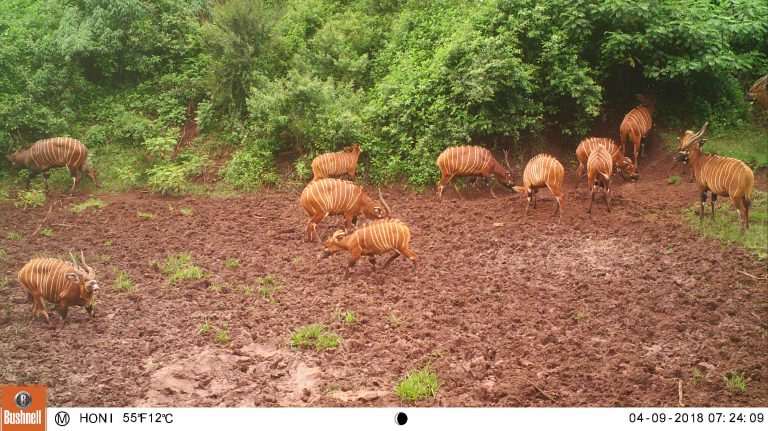
MALTE SOMMERLATTE Mike Prettejohn is the guru! We at Ragati are newcomers to the bongo – but delighted to be involved in Mike’s Bongo Surveillance Project. We also have help from Christian Lambrechts, Executive Director of Rhino Ark and Belgian negotiator and diplomat. We’ve written a summary of what’s happened here to get appropriate authority. We’ve shared it with the Bongo Surveillance Project, and it will eventually go to the KWS Conservancy Board.
NWNL Mike, since you are tagged as “the guru,” what is your bongo news?
MIKE PRETTEJOHN Since 2003, we have mapped all Mau Forest bongo sites where we’ve gotten bongo photographs or found bongo dung or tracks. At the moment, there are no more than about six wild mountain bongo left in the Mau Forest. In the last two years we’ve had photographs of only one female.
For the protection of bongo when initially reintroduced at Ragati, we’ll employ additional community scouts; have a station here where researchers can stay; and monitor and track bongo when released while people are studying their behavior. For now, our contribution will be a pied-á-terre for bongo researchers – as well as building the bongo pens and other required infrastructure.
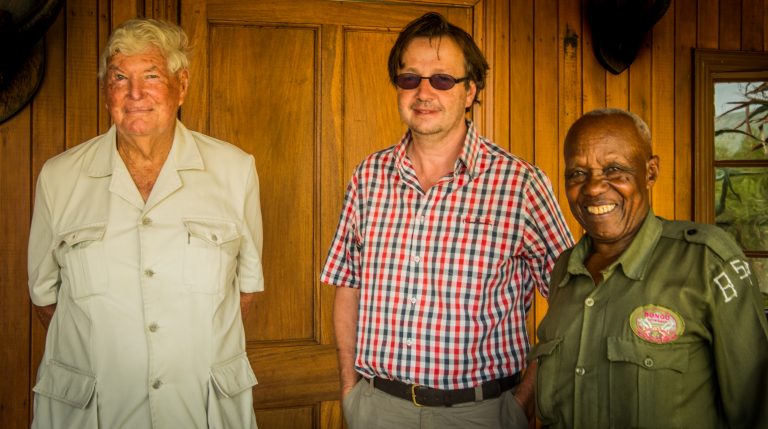
NWNL What are Ragati’s future goals and projects? You mentioned a trout farm, a feasibility study, and eco-education that includes a research station, university affiliation and field courses for adults and children.
MALTE SOMMERLATTE This is the fun part because we can vent our enthusiasm on those future goals. All our future projects are of equal priority.
Trout Farm & Feasibility Study:
MALTE SOMMERLATTE Before launching Ragati Conservancy, I asked our manager, Eustis, to do a consultancy on our idea of a trout farm. It’s shuffling along; but it produces 2-3 tons of fish every year. One or two people are interested in investing. But, for now, we’re inclined to do it ourselves step-by-step, putting in a few ponds, and gaining experience as we develop and add more ponds. Our objectives include producing commercial-size trout to sell to lodges and camps and restocking the Ragati River and other rivers. A very keen Dutch or Belgian fisherman did an analysis and feasibility of the Ragati River.
Research Station/Camp:
BRENDAN HILL Regarding our eco-education goal, KFS really wanted ecotourism in this area. Thus, they opened channels for education on preservation, because it’s clear that the local people will look after wildlife and forests, if it’s done in a correct manner.
MALTE SOMMERLATTE One eco-education goal is to set up a research station here with a camp for 4-5 students who’d be supervised by North American, European or local professors.
University Affiliation:
I would very much like for this Ragati Research Station to have a local university association. We’d provide facilities and a cook, renting it on a monthly or any other basis. Visiting students would do research in forest ecology, climate change, river ecology and so forth. I think there’d be a huge demand.
NWNL Are there any similar models in Kenya to base this on?
MALTE SOMMERLATTE This would be the first of its kind in Kenya; but there is one in Tanzania. I’ve never met that director, but we’ve corresponded.
Adult Ecosystem Field Courses:
MALTE SOMMERLATTE Then, I’d like to offer 5 to 6-day field courses in forest ecology, forest wildlife and so forth for anyone interested. We have the facilities. Then, if successful, we could do a course in savanna ecology, desert ecology, addressing other ecosystems and big game.
Tom Butynski, an excellent American zoologist, runs a little research station on Lolldaiga Hills Ranch, 20 kms. north of Mt. Kenya. He said, “Malte, if you do forest ecology there, why not a 1-week course in savannah ecology here?” So, forest ecology courses could be here; savanna courses at Lolldaiga and then semi-desert/ desert ecology courses on a conservancy or branch of Northern Rangelands Trust.
Having lived and worked in many African countries, I know Kenya is quite unique. You can fish for trout here on Mt Kenya in the morning; and 4 hours later you can be in a desert with only 250 millimeters of rain per year. In South Africa, where I grew up, you had to drive 2 days from Johannesburg into the Karoo, the Kalahari, or Namibia to find savannas or desert. Here, just 3-4 hours! That’s why I’d have courses on three very disparate ecosystems.
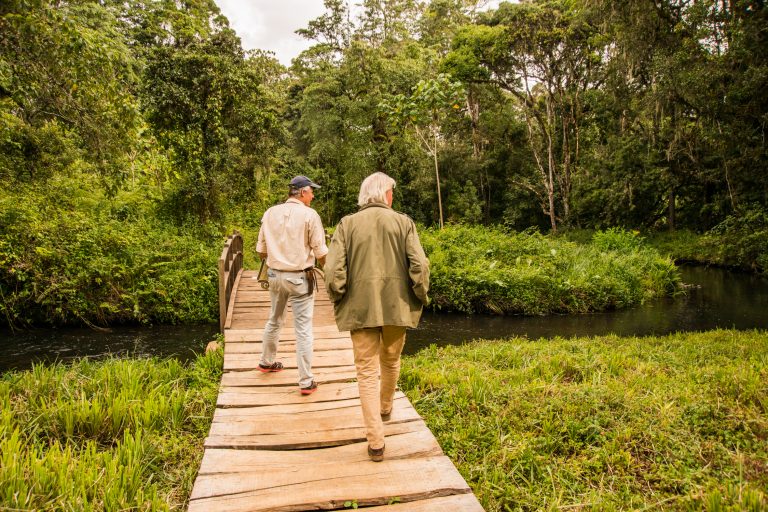
Children’s Fishing Camps as Eco-Education:
BRENDAN HILL Fishing and environment go together and are a fantastic way to educate young local people. If you get them fishing – especially trout fishing – you’ll preserve these areas. So, Kenya’s water catchment areas are prime spots for educating young people.
NWNL How do you most easily interest young local Kenyans in forests?
BRENDAN HILL When schoolchildren come here for our survival courses, they learn to catch and gut a fish, and live “in the bush.” First day, they have an orienteering trip to learn about the forest, fire-lighting and things that take them back to the past. We want them to know this terrain.
NWNL Beyond your commitment to community orientation, once you fulfill your debt payments will you share a percentage of Ragati’s income with the community as a contribution, not just as employment?
MALTE SOMMERLATTE We need to do more community development and training, specifically on skills for mountaineering guides, porters, ghillies and staff cooks.
BRENDAN HILL Many community-oriented projects do that. But I don’t feel throwing candy over the hedge is the best approach. It’s better to set up projects that the community can run. For instance, they can make worm tanks to produce fish food, or on our lower elevations, perhaps they could produce a Ragati tea, pack it and sell it. We would build a little packing house next to it that could be community oriented. There’s also an opportunity for bamboo growing, and other businesses in a quite distant future.
MALTE SOMMERLATTE I also think there’s great danger to have too many goals. In my 80 to 90 consultancies in wildlife and community projects. I’ve learned that one needs to concentrate, concentrate, concentrate. We’re already on the way to doing too many things. It’s fun thinking of projects, but one must be realistic.
I think it’s best to train them and to give them a job, not hand out money. Thus, I’m keen to set up a Trust so profits from specific projects can benefit certain training schemes. We’re open to suggestions, but that’s our reasoning behind establishing a Trust.
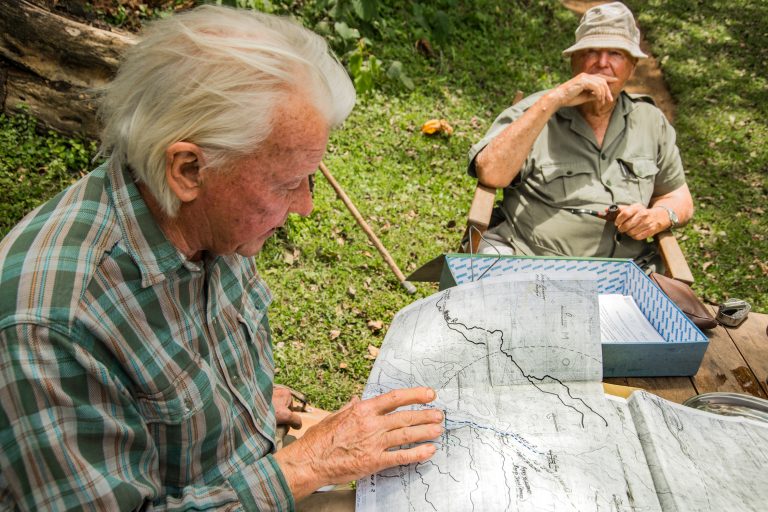
NWNL Malte, congratulations on all you’ve accomplished thus far: bongo pens, a fishing camp, stocked trout, community scout training and so much more. Good luck as you move forward with your conservation vision.
Posted by NWNL on August 30, 2021
Transcription edited and condensed for clarity by Alison M. Jones.
All images © Alison M. Jones. All rights reserved.
